#mecistops cataphractus
Explore tagged Tumblr posts
Text
Some recent croc encounter
Ive been on „vacation“ last week which honestly was mostly taking a friend to various zoos and aquariums across Austria, but that did lead me to getting to see a fair share of crocs in a fairly short time span.
Right on day 2 it was another meeting with Leila, the female Mecistops that resides in Viennas aquarium. This is now my second time seeing her and shes still a beauty.


A day later we visited the House of Nature museum in Salzburg, which had just opened its new reptile halls. As part of the makeover, which focused a lot on cohabitation and larger, natural exhibits, the museum had go part with its American Alligator that had simply become too large. While I did subsequently miss out on seeing it again after like two decades, they did get a new crocodilian in its place, a much more manageable dwarf crocodile.


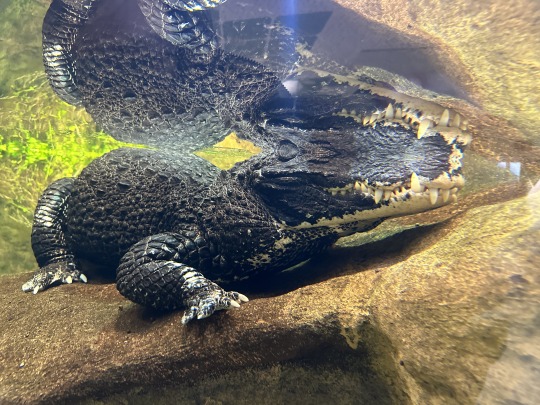
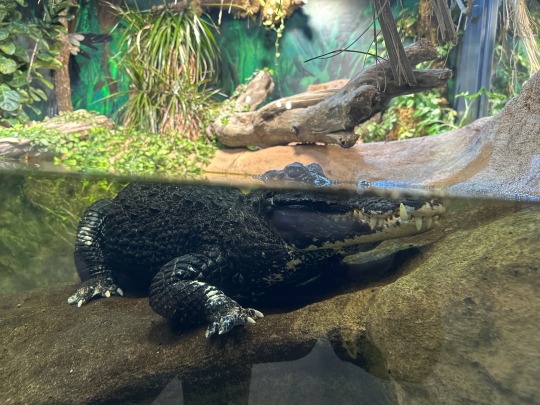
The first room furthermore featured two skulls, one of a crocodile and one of a gharial, nicely highlighting the diversity of modern crocodilians. Downstairs in the dinosaur hall they also displayed the skeleton of Macrospondylus, but given how common fossils of that animal are I wont dwell on it beyond saying that its size was rather impressive.


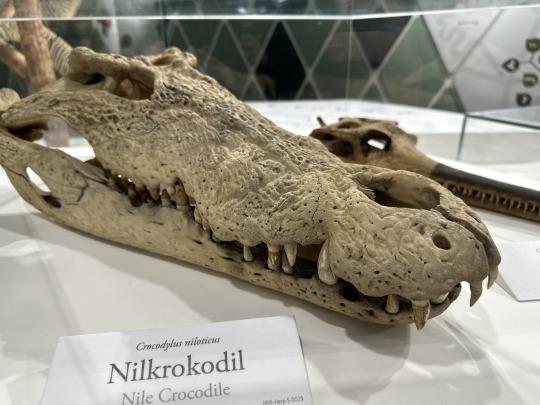
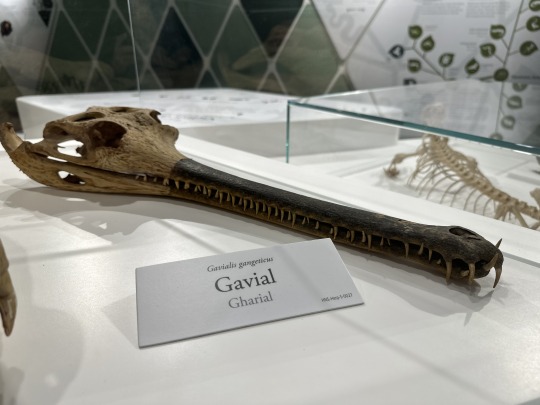

Skipping ahead a few days brought us back to Salzburg, this time to the zoo just outside the city. While featuring nothing too large, the jaguar house still showcased a crocodilian, specifically a dwarf caiman. Alas, despite stopping by around 5 times, it was less cooperative in terms of posing than my previous two encounters. Still, the enclosure was quite nice and featured some cohabitation with basilisk lizards and bats (that I sadly couldn't find).




The last zoo of the week was in Schmieding in Upper Austria. Now when I was a kid they had a nile and, in the adjacent aquarium, some spectacled caimans. However nowadays they scaled down, having moved the caimans into the old nile crocodile pool in the rainforest house. Funny enough they were the only ones on the trip to have been on land, tho they were looking a little rough if truth be told.

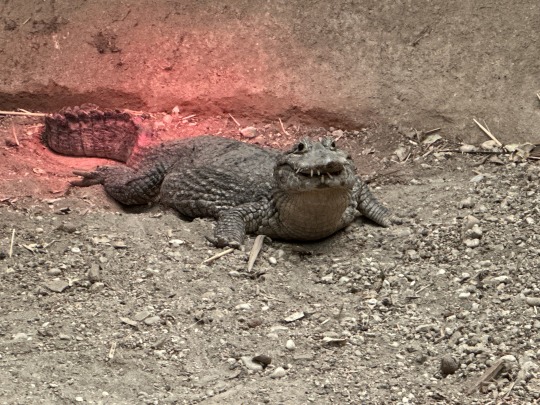
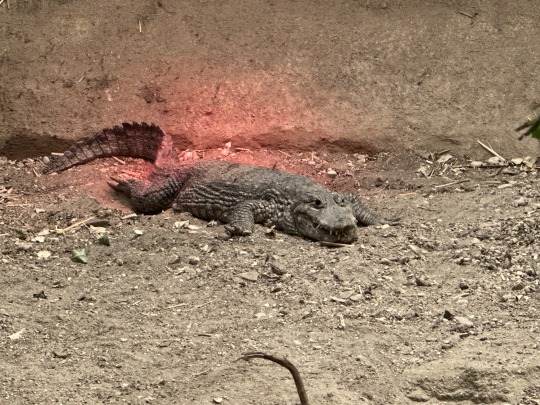
And that was it in broad strokes. Some were certainly more exciting than others, Leila remains a stand out and the new Salzburg Osteolaemus was nice to see. Obviously the trips featured a lot of other interesting stuff from 9 meter sturgeon models in Bratislava to free roaming ringtail lemurs and stuffed rhinogrades in Salzburg and plenty more, but alas all four species encountered were animals I have seen before, so I don't get to cross anything off my list this time around.
#haus des meeres#vienna#mecistops cataphractus#slender-snouted crocodile#haus der natur#museum#salzburg#osteolaemus#dwarf crocodile#gharial#nile crocodile#macrospondylus#dwarf caiman#zoo salzburg#paleosuchus#paleosuchus trigonatus#zoo schmieding#caiman#spectacled caiman#crocodiles#croc#pseudosuchia#crocodilia
65 notes
·
View notes
Note
So we've seen some excellent albinism, what melanistic creatures look particularly magnificent?
Melanistic Animals...
Some of my favorite melanistic friends are crocodilians.
Have a look at this beauty...


West African Slender-snouted Crocodile (Mecistops cataphractus), family Crocodylidae, found in West Africa
CRITICALLY ENDANGERED.
photographs via: The Dragonwood Wildlife Conservancy
1K notes
·
View notes
Text
Fun Fact Friday: West African Slender-Snouted Crocodile
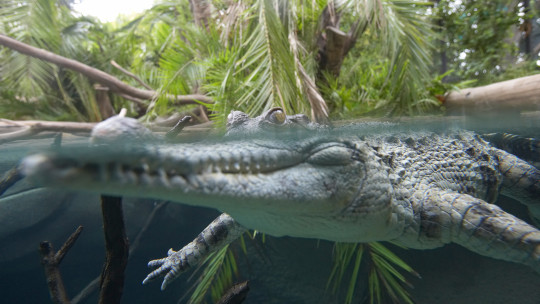
Image Credit: San Diego Zoo
Fun Fact! West African Slender-Snouted Crocodiles(Mecistops cataphractus), despite their unnerving appearances, can be amazing parents. The mothers will guard their nests until the eggs hatch. She will then dig up the nest and very gently help the remaining unhatched babies to hatch by carefully cracking their shells. The mother and sometimes the father will then protect the young until they become independent.
#animaloftheweek#funfactfriday#wildlife#zoology#animals#aotw#animal facts#conservation#weird animals#fun facts#cool animals#ecology#crocodiles#crocodilian#reptile#west African slender snouted crocodile
135 notes
·
View notes
Text
species found!
this is perhaps evil but I can boost my mood in almost any situation by playing a game called "what was my mom doing at this age?" like rn for instance I'm sleepy because I had a 12 hour work day + stayed up late, and my stomach hurts a little from the enormous chimichanga I smashed for dinner, and my head hurts a little bit from the fat margaritas I had with the chimichanga. and it's like hmm, okay, not optimal, but when my mom was this age she had a 2.5 year old to deal with. can you fucking imagine. can't stay in bed decadently bemoaning your overindulgences because there's a goblin in the next room that's utterly dependent on you for food and hygiene and social needs and if you drop the ball you've fucked up a perfectly good person. and I'm pretty normal so shout out to her for keeping it together but god that couldn't be me, I like fucking around way too much.
Slender snouted crocodile (Mecistops cataphractus)

listed as Critically Endangered
this is perhaps evil but I can boost my mood in almost any situation by playing a game called "what was my mom doing at this age?" like rn for instance I'm sleepy because I had a 12 hour work day + stayed up late, and my stomach hurts a little from the enormous chimichanga I smashed for dinner, and my head hurts a little bit from the fat margaritas I had with the chimichanga. and it's like hmm, okay, not optimal, but when my mom was this age she had a 2.5 year old to deal with. can you fucking imagine. can't stay in bed decadently bemoaning your overindulgences because there's a goblin in the next room that's utterly dependent on you for food and hygiene and social needs and if you drop the ball you've fucked up a perfectly good person. and I'm pretty normal so shout out to her for keeping it together but god that couldn't be me, I like fucking around way too much.
39K notes
·
View notes
Text
West African Slender-snouted Crocodile

Mecistops cataphractus

🔔 This species of crocodile was first described in 1824 and was thought to be distributed across West Africa and into Central Africa but the Central African species has been separated as the Central African Slender-snouted Crocodile (Mecistops leptorhynchus) based on studies in 2014 and 2018 that indicated that both were distinct species based on DNA analysis.
0 notes
Text
Species
There are a total of 18 extant species have been recognized.
American crocodile (Crocodylus acutus)
Hall's New Guinea crocodile (Crocodylus halli)
Orinoco crocodile (Crocodylus intermedius)
Freshwater crocodile (Crocodylus johnstoni)
Philippine crocodile (Crocodylus mindorensis)
Morelet's crocodile (Crocodylus moreletii)
Nile crocodile (Crocodylus niloticus)
New Guinea crocodile (Crocodylus novaeguineae)
Mugger crocodile (Crocodylus palustris)
Saltwater crocodile (Crocodylus porosus)
Borneo crocodile (Crocodylus raninus)
Cuban crocodile (Crocodylus rhombifer)
Siamese crocodile (Crocodylus siamensis)
West African crocodile (Crocodylus suchus)
Osborn’s dwarf crocodile (Osteolaemus osborni)
Dwarf crocodile (Osteolaemus tetraspis)
West African slender-snouted crocodile (Mecistops cataphractus)
Central African slender-snouted crocodile (Mecistops leptorhynchus)

5 notes
·
View notes
Photo
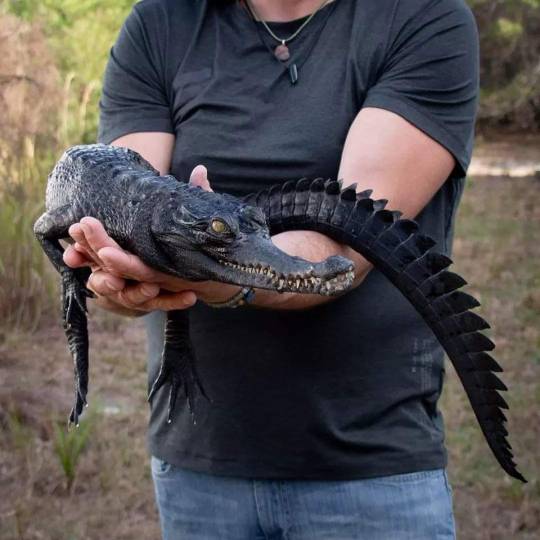
🔥 Rare Melanistic West African Slender-snout Crocodile (Mecistops cataphractus)
2 notes
·
View notes
Note
So the african cryptids were removed, but do you have the art/entries for them saved somewhere? It’d be interesting to see, and might work as a sort of “sneak peak” without revealing any actual book content
Art and bio entry were done on paper, but I do have the mythology entry recycled into the makara/grootslang chapter (as this animal has a range covering South Asia, West Asia and Africa) and it looks a little like this:
Cryptozoology in the Congo Basin:
The Congo Basin in Central Africa contains one of the largest areas of undisturbed rainforest in the world. It is home to both pygmy civilisations and tribes from the Bantu language groups. Europeans will often use the Congo rainforest as an imagined home for all sorts of monsters; the pseudoscience of cryptozoology (the study of ‘hidden animals’) places many terrifying reptiles in this area.
Many of these imagined creatures, or ‘cryptids’ have features of both elephants and reptiles, and therefore may be inspired by the makara, who has been known to live in that part of Africa.
The most famous of these cryptids is mokele-mbembe – a cryptid loosely based on local words of the Bangala people. The cryptid was first reported by Carl Hagenbeck in 1909 as a mysterious ‘half elephant half dragon’. In 1913 Ludwig Freiherr von Stein was the first to report the name Mokele Mbembe, and added that it was brownish grey in colour, the size of an elephant, a long neck, a single long tooth or horn. The animal was known to attack boats but leave its victims dead and uneaten. Since 1913 there have been 12 more expeditions into the Likouala swamp region specifically in search of the Mokele-Mbembe, with results ranging from rare sightings to just broken twigs.
German adventurer Lt Paul Gratz in 1911 reported a crocodile-like creature with scale-less skin and clawed toes in Lake Bangweulu, and named it Nsanga.
Alfred Aloysious Smith’s 1927 memoir about exploring the Congo mentions the discovery of a giant pan-sized footprint with three claws – he named the owner of this footprint Amali. He also mentions the Jago-Nini or ‘giant diver’, who was known to emerge from the water to eat people.
While many of these monsters can silently sneak up on people, the Mbielu-Mbielu-Mbielu is known for its loud ‘mbielu’ call, and is named for it. Mbielu-Mbielu-Mbielu is a large reptile with ‘planks’ or wedge-shaped plates coming out of its back in the Likouala region of the Republic of Congo, reported by the people living in the villages of Bounila and Ebolo.
Another creature, the Nguma-monene was sighted near the Dongu-Mataba river, with a low slung belly, and triangular dorsal plates similar in appearance but smaller than those found on the Mbielu-Mbielu-Mbielu; another large and dangerous reptilian animal first sighted by a European but barely mentioned in local mythology, reported by Joseph Ellis in 1961 and in 1971.
The Emela-ntouka (or ‘killer of elephants’, also called Aseka-moke or Ngamba-namae) is a large brown animal possessing a single horn or tusk, lacking dorsal plates or ridges (a common feature in many Congo lake monsters) and has the overall appearance of a reptilian rhinoceros with elephant ears. One of the earliest descriptions of this animal was in 1954 by Lucien Blancou – a game inspector for Likouala game reserve. Two expeditions were made in 1980 and 1981 by Dr Roy P Mackal.
The Badigui or Ngakoula-ngou is described as giant snakelike animal, while the Chipekwe is a giant lizard that preys on hippos, elephants and rhinos. The Irizima, said to live in Lake Edward, is black, larger than a hippopotamus, horned, and breathes so heavily it can cause large waves in the water.
All these creatures are reptilian, some are serpentine, and many have the ears of an elephant, suggesting there is some connection with them and the makara. The only other large reptiles in the Congo Basin are the Nile crocodile (Crocodylus niloticus), the West African slender snouted crocodile (Mecistops cataphractus), the African rock python (Python sebae), none of which are so monstrously huge that they could tackle rhinos and elephants.
Some notes
As this was lifted from a list of notes I have on world mythology, the prose in itself is almost list-like. I know a few people who are better at sentence structure than I am, and will get notes from them in the next edit.
Also the ‘makara’ is a creature from Indian mythology. I have a dragon with elephantine features (which are always changing, so I’m not posting the biology bio yet until I have this down to a point!) and I am using the ‘elephant dragon’ chapter to talk about the Makara in Indian mythology, the Grootslang in South African and sometimes Benin mythology, a brief overview of cryptids in the Congo and some links to ‘Mesopotamian Chaos Serpents’ - these are huge aquatic serpents with vast ranges, and therefore dwell in a variety of locations. In my 2020 rewrite I might make the Indian, West Asian and African ‘elephant faced dragons’ into different species or subspecies, or I will keep them all as one very diverse species. Who knows?
Sharing My Work
Obviously I need to share more stuff, but for things with complete bios AND complete images, I need to go back to 2017, or I would need to show current works in progress - the former option shows outdated words and art, the latter option shows things which are in constant change.
When I complete a full 2020 rewrite of a chapter, should I put the 2018 version of the chapter somewhere on my blog for easy access? I was planning to have a gallery of 2017 artworks and maybe the 2018 artworks as well if I replace them all with new art, but would art+writing be appreciated?
7 notes
·
View notes
Link
“The African slender-snouted, or sharp-nosed, crocodile (Mecistops cataphractus) is medium-sized, lives in freshwater habitats, and, as its name suggests, has a long and slender snout,” said team leader Dr. Matthew Shirleyof Florida International University’s Tropical Conservation Institute and colleagues.
“When we analyzed the DNA and physical characteristics of crocodiles in the wild and in captivity in six African countries, we found two distinct species of slender-snouted crocodiles: one unique to West Africa and one unique to Central Africa.”
Named the Central African slender-snouted crocodile (Mecistops leptorhynchus), the newfound species is the first new living crocodile species to be described in nearly 85 years.
“At first glance, the West African and Central African slender-snouted crocodiles appear quite similar,” the scientists said.
“In addition to the differences in their DNA, we found differences in the skull shape and scales that strongly support the existence of two species.”
The International Union for Conservation of Nature (IUCN) listed slender-snouted crocodiles as ‘Critically Endangered’ in 2014.
64 notes
·
View notes
Text
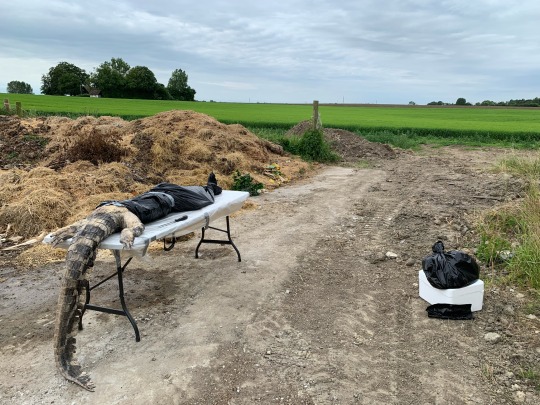
Just a picture from the office today.
#crocodile#dissection#biology#necropsy#natural history#Zoology#cw: dead animal#Mecistops#Mecistops cataphractus
573 notes
·
View notes
Text
Today I finally got to cross another crocodilian off my list, specifically Mecistops cataphractus. This is because one, Leila, originally owned by a Swiss author, has moved in to replace the enormous false gharial Adam at the Haus des Meeres in Vienna.
I stopped by twice today and though during my first visit of the day she was just lazily resting in a corner of her pool, the second time around I got lucky enough to see her swimm around a bit. Despite a length of "only" 2.7 meters she's quite the impressive sight none the less.
I also managed to get a still image from just before I left when she settled in one of the shallower parts of her pool, nicely showing how dark her scales are. To my knowledge she is the fourth crocodilian species kept at the aquarium.
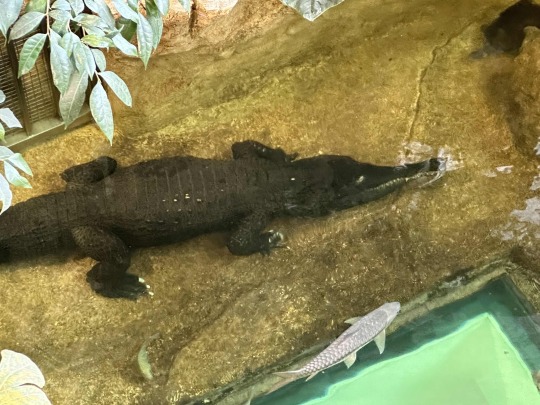
#mecistops#mecistops cataphractus#slender-snouted crocodile#crocodilia#west african slender-snouted crocodile#crocodile#haus des meeres#vienna
49 notes
·
View notes
Photo

anthropocène, serie of embroidered installations (wip) Mecistops cataphractus (slender-snouted crocodile), critically endangered. The slender-snouted crocodile is a narrow-snouted, medium-sized species reaching a maximum length of 4m, though individuals over 3m are now rare. Population decline in the past has been attributed to the commercial skin hunting, subsistence hunting and habitat destruction. Currently, hunting for skins in central and west Africa has abated, largely as the result of declines in crocodile populations and to a lesser extent from restrictions on international trade established by CITES. Mecistops cataphractus populations are threatened by fisheries (resulting in a reduced prey base and incidental mortality in fishing nets), habitat loss (large tracts of forest are cleared for cacao and rubber plantations or settlements) as well as ongoing limited hunting for the bushmeat markets. A recently renewed initiative in Côte d'Ivoire is looking at captive breeding and reintroduction. source : www.iucnredlist.org #embroidery #broderie #slendersnoutedcrocodile #endangeredspecies #hunting #habitatloss #deforestation #fishing #bycatch #crocodile #especesmenacees #peche #chasse #anthropocene #anthropoceneDMJ #wip
#habitatloss#especesmenacees#endangeredspecies#deforestation#slendersnoutedcrocodile#bycatch#chasse#broderie#anthropocene#peche#hunting#fishing#anthropocenedmj#embroidery#crocodile#wip
2 notes
·
View notes
Text
Conservation: West African Slender-Snouted Crocodile
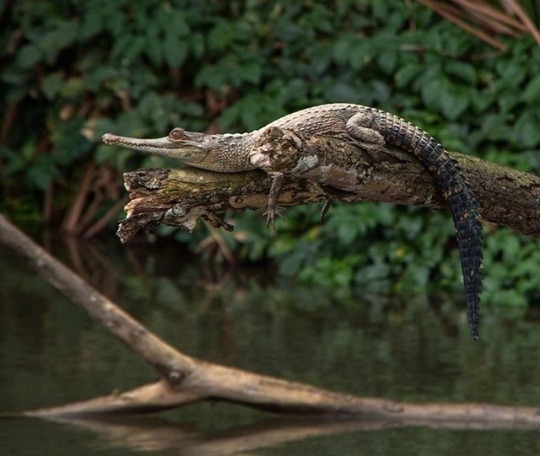
Image Credit: Unknown, possibly Andrea Brum-Oome
Conservation Tuesday! Unfortunately, the West African Slender-Snouted Crocodile(Mecistops cataphractus) is considered by some to be one of the most endangered reptiles in the world. They are listed as Critically Endangered and very little is known about them. Their main threats are habitat loss, depletion of prey, and hunting for meat and skin.
#animaloftheweek#conservationtuesday#wildlife#zoology#animals#aotw#animal facts#conservation#weird animals#fun facts#cool animals#endangered animals#endangered species#endangered#critically endangered#crocodilian#crocodile#west African slender snouted crocodile#reptile#reptiles#ecology
7 notes
·
View notes
Photo

•origen: África •Nombre científico: Mecistops cataphractus •Estado de conservación: En peligro crítico (Reducción) •El cocodrilo hociquifino africano (Mecistops cataphractus) es una especie de saurópsido crocodilio catalogada como tal por Cuvier en 1875. Es una de las cuatro especies de cocodrilos que habitan en África —junto con el cocodrilo del Nilo, el cocodrilo del desierto y el cocodrilo enano—. •Este cocodrilo habita zonas occidentales del África Central, mayoritariamente Congo y Costa de Marfil, en ocasiones cerca de las desembocaduras, llegando incluso a encontrarse ejemplares en la isla de Bioko lo que demuestra cierta tolerancia a la salinidad. Habita preferentemente en zonas de vegetación densa, llevando una vida acuática. En su edad adulta puede alcanzar los 4 metros de longitud, aunque normalmente su media se sitúa en torno a 2,5 metros. • Precisamente es denominado hociquifino por tener un hocico algo más estrecho que el de parientes cercanos, siendo al menos 5 veces más largo que ancho en su edad adulta. El color de su piel es oliva oscura en su parte superior y clara y con manchas en su parte inferior. En los ejemplares jóvenes presenta matices más claros. #cocodrilohociquifinoafricano #cocodrilohociquifino #cocodriloafricano #cocodrilo #cocodrilos #alligator #alligatorgar #alligators #animales #animal #animals #naturaleza #natural #nature #naturephotography https://www.instagram.com/p/CDOhILYDpDj/?igshid=1cq9c9lv1y660
#cocodrilohociquifinoafricano#cocodrilohociquifino#cocodriloafricano#cocodrilo#cocodrilos#alligator#alligatorgar#alligators#animales#animal#animals#naturaleza#natural#nature#naturephotography
0 notes
Photo

April 2020 Slender-Snouted Crocodile (Mecistops cataphractus) Join a creative community focusing on a unique animal each month. Create art inspired by the featured animal and share it with #FaunaFocus. Check FaunaFocus.com for FaunaFacts the Free-For-All art competition & live critique, featured artists, special events, and more! Images 1.-3. ©️ Jeremy Thompson, Some Rights Reserved (CC BY 2.0) 4. ©️ Martin Pettitt, Some Rights Reserved (CC BY 2.0) 5. ©️ Mark Seton, Some Rights Reserved (CC BY-NC 2.0) 6. ©️ Animal Diversity Web, Some Rights Reserved (CC BY-SA 2.0) 7. ©️ John Wright, Some Rights Reserved (CC BY-NC-ND 2.0) 8. ©️ Josh More, Some Rights Reserved (CC BY-NC-ND 2.0) 9. ©️ Tim Strater, Some Rights Reserved (CC BY-SA 2.0) 10. ©️ Matthew Baldwin, Some Rights Reserved (CC BY-NC-ND 2.0) #artchallenge #artprompt #animals #wildlife #slendersnoutedcrocodile #slendersnoutedcrocodiles #crocodile #crocodiles #reptile #reptiles https://www.instagram.com/p/B-h3PB0jFbq/?igshid=l2zrjm0sh3ip
#faunafocus#artchallenge#artprompt#animals#wildlife#slendersnoutedcrocodile#slendersnoutedcrocodiles#crocodile#crocodiles#reptile#reptiles
0 notes
Text
Central African Slender-snouted Crocodile

Mecistops leptorhynchus

🔔 It was considered to be of the same species as the West African slender-snouted crocodile (Mecistops cataphractus). Their genetics diverged more than 8 million years ago. As both populations continued to evolve, the genetic drift caused a difference of more than 5% in important genes. Base on the analysis of DNA it was established as a separate species in 2018.
1 note
·
View note